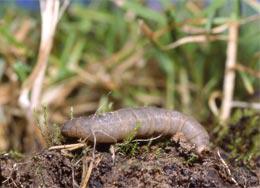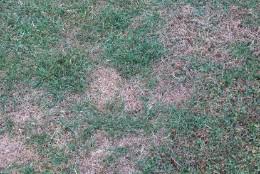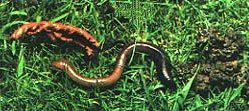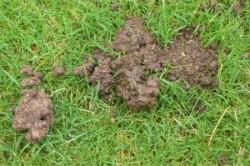Pests
Leather Jackets are the larvae grubs of the Crane Fly (Daddy Longlegs). Leather Jackets in lawns are a real pest and can have severe consequences unless killed. They are a pest of the lawn, for they eat the roots of the grass plants causing the grass to die. A small infestation is nothing to worry about. However if you have a lawn full of Leather Jackets then the effect can be quite dramatic. In worse cases, resulting in much of the lawn dying and needing substantial remedial treatment.

First signs of a Leather Jacket attack are during the spring and summer, when small brown patches appear in the grass. This is the result of the grubs feeding upon the roots of the grass. The severity of the problem is dependent upon the number of Leather Jackets, and can start as just a few small patches a few inches across – hardly noticeable in an average lawn.
Other signs of Leather Jackets in lawns will be birds – mainly starlings – pecking at the lawn to get at the grubs. The birds also do a good job of aerating the lawn, for their beaks can penetrate several inches. It does no damage to the lawn. If you do not treat the Leather Jacket grubs, then you will also see a large number of crane flies hovering above the lawn area as the grubs emerge as Daddy Longlegs Flies.
These adult flies then lay eggs in the lawn during autumn, which shortly hatch and start feeding on the lawn roots. The feeding normally stops in winter – unless it is mild – but soon resume again in the spring – thereby completing the cycle as above for Leather Jackets in lawns.
Chafer Grubs

Chafer Grubs in lawns.
The larvae - grub - of the chafer beetle can do considerable damage to lawns, as it lives it's life under the turf - eating away at the grass roots. The Chafer Grub feed on the roots of the lawn turf during spring and summer. Whilst not as much of a problem as Leather Jackets, they can still leave the lawn with several dead patches as shown in the image above. Small brown patches of turf, which can easily be pulled away are the tell-tale signs of the chafer grubs in lawns, together with birds pecking down into the lawn. Starlings, crows and magpies in the main, together with a few animals such as foxes, badgers and moles which scratch into the lawn in search of this juicy morsel! In light soil areas, the chafer grubs can be controlled by rolling the lawn in spring - this crushes them. However, this should not be carried out in heavy soil areas.

The larvae of the chafer beetle.
This grub spends it's life under lawns - eating the roots of the grass. More damage is done by predators scratching at the lawn than by the grub itself. However, the yellow spots in the lawn are unsightly in well maintained lawns. Isolated spots can be dug up with a daisy grubber in order to find the grubs, then carefully eased back after disposing of the grub - which is normally a few inches under the turf.
The chafer grub in the image is well advanced. Younger grubs will not have the legs formed as in this image.
Worms
Worms can be a bit of a pain in nicely manicured lawns when they leave their worm casts all over the place - normally in the autumn. Even so, we would not advocate any chemical control for worms in the grass areas! Boxing clippings from the lawn will go some way to lessen the problem - the worms thrive upon them. However, even the best tended lawns have an adequate supply of dead and rotten grass just below the green sward for worms to feed upon. They seem to prefer alkaline rather than acid soils (on lawns at any rate), so long term applications of high nitrogen fertilizers will help.

The best way to get rid of worm cast, is by brushing them off - when they are dry. A wire rake is good for this - better than a brush. Or if you have a large lawn, a 'drag-mat' made from wire mesh is a good idea. The earthworms that throw casts in the lawn are not beneficial insofar as drainage and aeration are concerned.
Dogs
The main problem with dogs on lawns is that of the brown patches caused by bitch’s urine. Male dogs are not a problem in this respect. The brown patches tend to be a circular patch with bright green grass growing around the perimeter as the bitches urine eventually breaks down to nitrogen, which then feeds the area outside the actual damage. The brown patch is basically scorching - similar to that caused by applying too much fertilizer - especially in dry conditions. Treatment by soaking the area with water - immediately after the bitch has done the deed! Soaking the brown patches after they have formed will be absolutely essential if you are going to over-seed the patches. As with many things, prevention is better than cure. You - the owner - have the remedy. Keep your bitch off the lawn!

Another problem as a result of keeping dogs is the severe compaction that can be caused - ultimately leading to the destruction of the lawn in many cases. The compaction and generally wearing of the turf, is when the lawn is used as an exercise area by the dog - or dogs. This is especially the case if you simply let your dog out onto the lawn in wet conditions - rather than taking it for a walk.
If you are going to use the lawn for this purpose, then you will need to have a maintenance regime for your lawn somewhat similar to that of a well-used football pitch. Certainly coarser hard wearing grasses will have to be used, and a more intense schedule of maintenance, including spiking etc will be needed, if you wish to have what is normally classed as a garden lawn!
